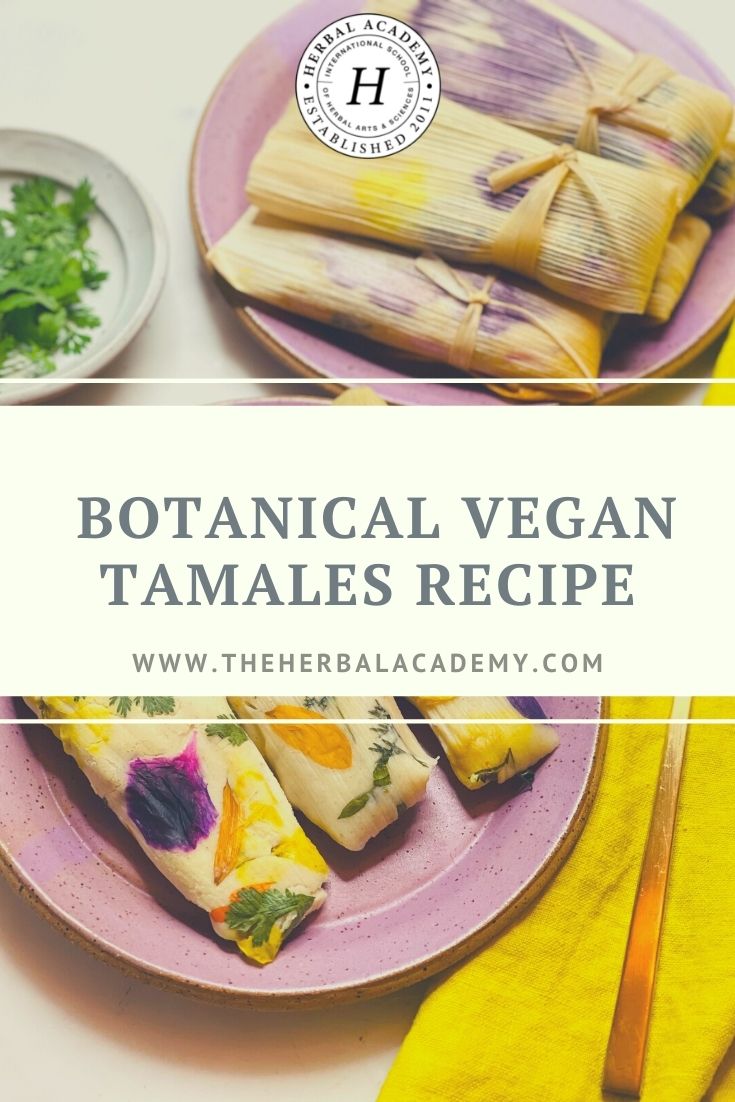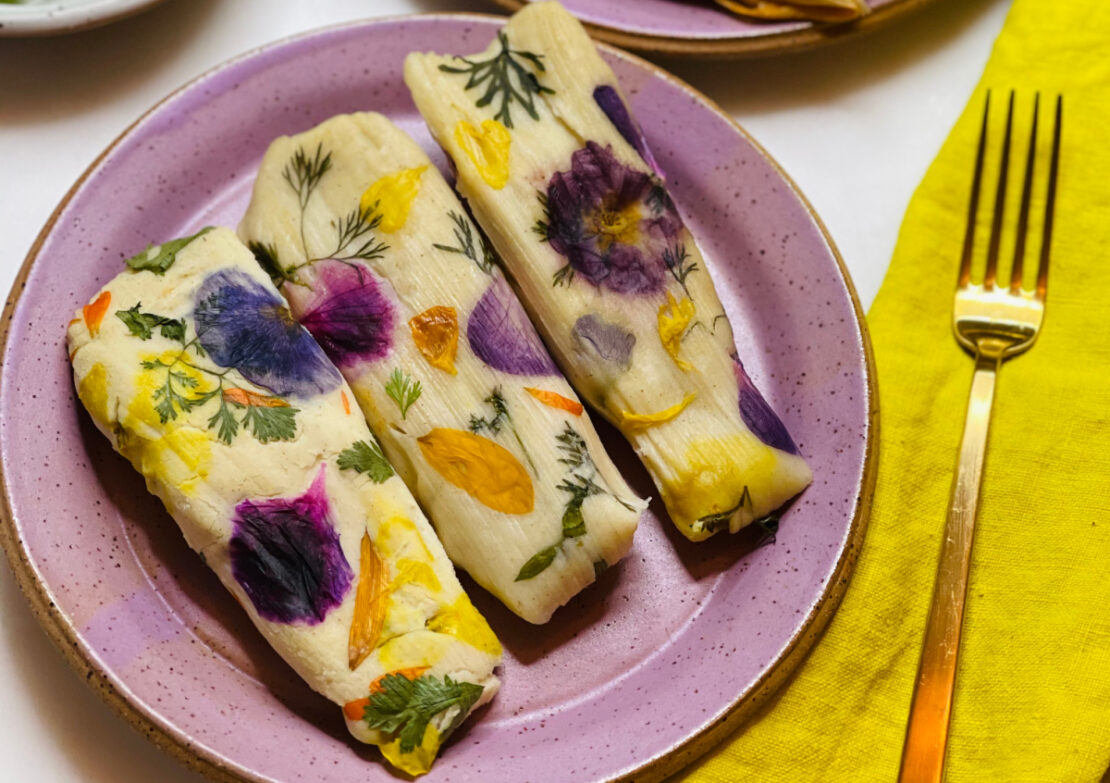
Botanical Vegan Tamales Recipe
This vegan tamales recipe is a fun twist on traditional tamales. I love how the edible flower colors and shapes appear to be painted on the masa after steaming. The spiced and hibiscus-infused jackfruit is a pleasing plant-based close companion in taste and texture to carnitas. You might find it more refreshing as a light alternative, for hot weather, lighter fare, or a plant-based diet. This recipe is also a great way to play with and show off your flair for using herbs, spices, and edible flowers.
Before we get started there are a few ingredients that typically garner a lot of questions, and as herbalists, you’ll want all the answers.
Vegan Tamale Ingredients
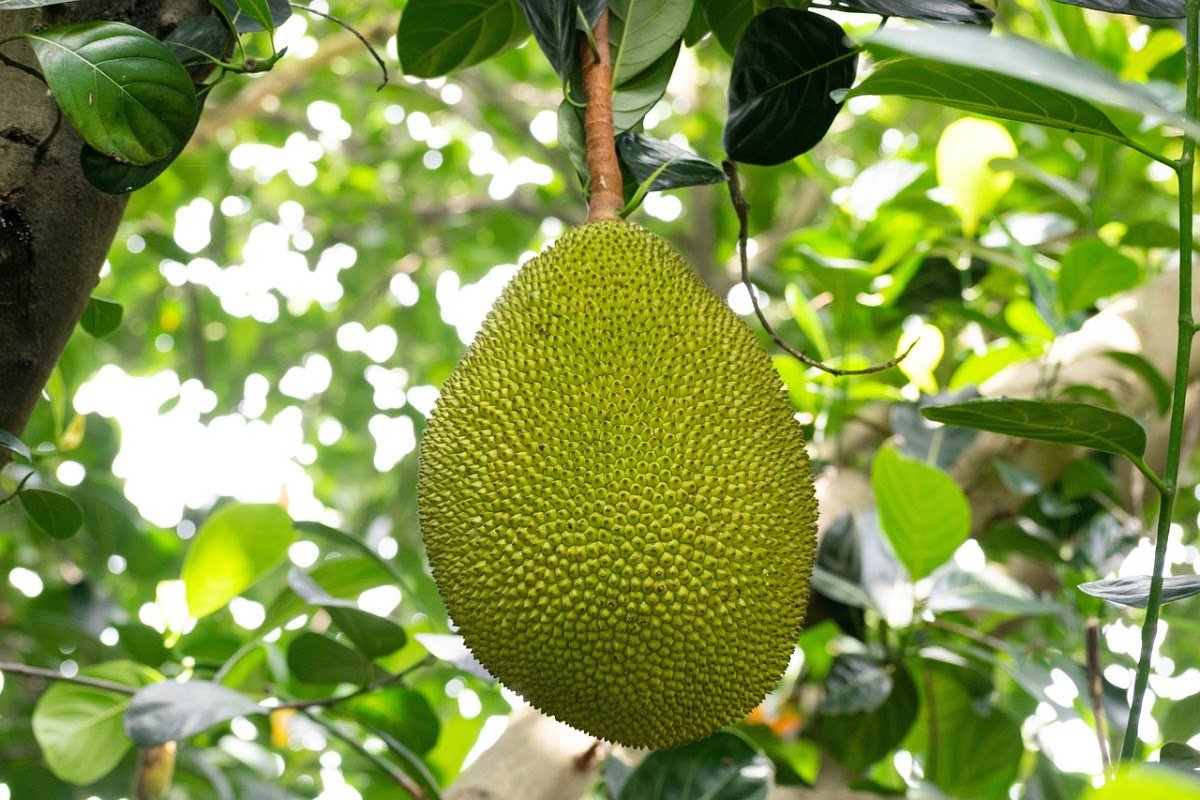
Jackfruit
Jackfruit (Artocarpus heterophyllus) is a light, sweet, fruit that will make up the body of the tamale filling. The flavor and texture are close to mango, with a hint of pineapple, though the scent, texture, and taste will vary depending on freshness and ripeness. You might find it bland until cooked with the spices, or you might find it intensely sweet. Anyone who really knows jackfruit from growing up with or cooking it will tell you it can be used as a fruit or a vegetable. Ripe it is eaten fresh as fruit – the inside that is! Unripe the firm pulp pieces can be cooked like squash in curries. For all of its inconsistencies in the market, you may want to warm up to using jackfruit with the canned version, which is suggested by the recipe below. You may also find it already separated from the skin and sectioned, packaged in a produce section or market. If you decide to go the heroic route, or have fresh jackfruit in your region, bring home a ripe jackfruit as close as possible to when you want to cook it and be prepared to sort through the inner fruit, eliminating any less desirable softer or slimy parts and saving the firmer, textured pieces of pulp to shred, spice, and simmer.
Whether you have a more ripe or less ripe jackfruit, as long as there are firm pieces you can press onward! If your jack is a bit less ripe you may experience a sticky milky latex. A bit of any cooking oil will free your knife from that stickiness after use. In any case, we will cook the fruit, and deepen the light orange color of the jackfruit pulp and add a flavor dimension by simmering it with red hibiscus and spices.
So where would you find a whole jackfruit (also called just jack, jack tree, jak, jaca, nangka, khanun, khnor, maki mi, may mi, and mit, and many other names) if you don’t already know it from your local cuisine? Tropical grocers and outdoor markets that sell a variety of produce are your best bet. Jackfruit is native to Southern India. We think it was initially cultivated in or around the Western Ghats mountain range, as one of the earliest cultivated fruits – an early achiever!
Traditions, cuisines, and agriculture, of many other tropical places, have adopted it too. If you are in India, Myanmar, China, Malaysia, Sri Lanka, Indonesia, the Philippines, Australia, New Zealand, Hawaii, any of the Pacific Islands, Florida, or parts of South America where it has been adapted, you may be putting your hand up eagerly to tell us more about this notable, prolific, and aromatic, unforgettable tree fruit!
You can recognize jackfruit in a market by a highly textured, goose-bumped, thick light green or beige outer skin, large size, dense feel, and irregular oval shape, cylindrical, or elliptical some say. Think of the durian fruit, but more oval-shaped than round, sweeter, not as pungent, and the skin is goose-bumped and less spikey. It’s in the mulberry family, may this help you remember, bumpy, not spiky, at least it is not as spikey as the infamous durian.
By the way, jackfruit is sometimes used as the main course both because of the huge size the fruits can reach, and because in addition to sugar it contains protein, fiber, and B vitamins.
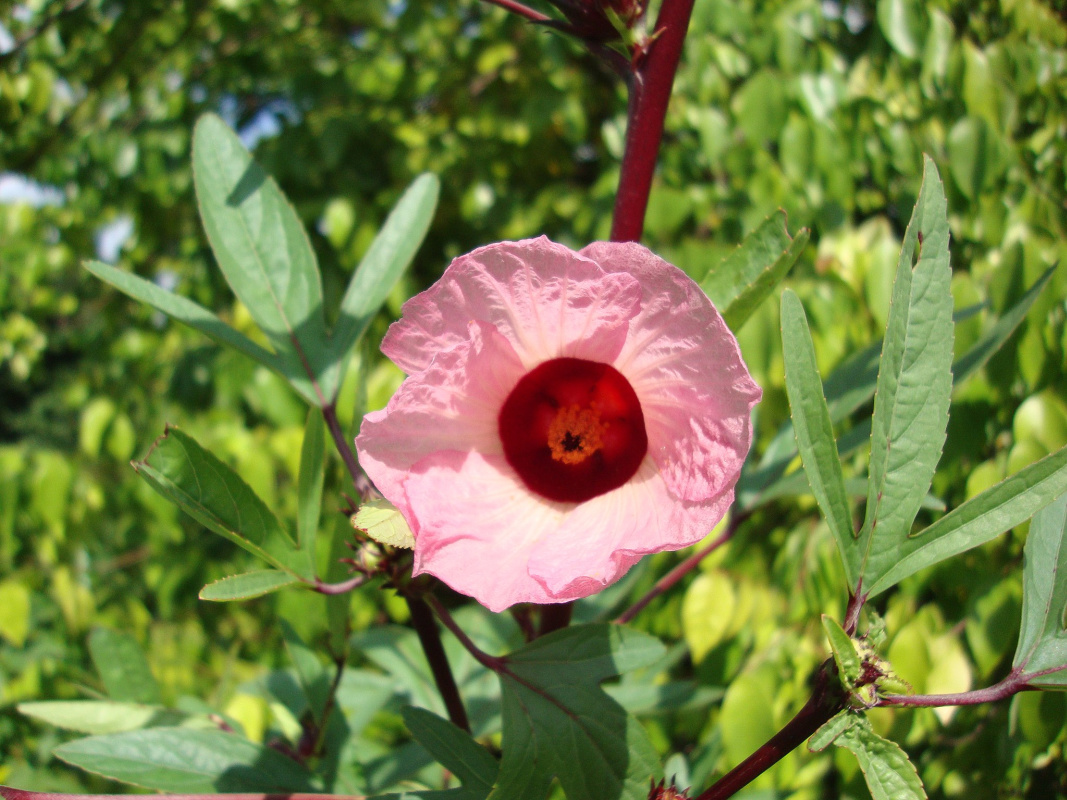
Hibiscus
Hibiscus is our snappy sidekick to jackfruit in this recipe. For herbalists not used to seeing roselle hibiscus where it grows, that is in tropical regions, such as West and East Africa, Southeast Asia including Northeastern India, Latin America, and throughout the Caribbean, explaining the vibrant red hibiscus in your tea or jackfruit tamale filling to your guests could be perplexing without this little pre-lesson, especially if your guests are only familiar with paler and ornamental species of hibiscus. “Is this the same as the hibiscus in my garden?” and “When does it turn it red?” are common questions of plant people and the culinarily curious.
Roselle hibiscus (Hibiscus sabdariffa) has a bright red calyx. The calyx is the typically non-showy part of the flower behind the petals that are usually green in most flowering plants. The red calyx of Hibiscus sabdariffa is the primary part used in herbal teas, agua jamaica, and in this case to infuse our tamale filling with vibrant dark red color turning the jackfruit red-orange.
If you can get your hands on the fresh calyces of a roselle hibiscus, those will be fun for an herbalist to taste, dissect, and work with, and increasingly herb and produce farmers are growing roselle and bringing pods to markets. Dried Hibiscus sabdariffa always has plenty of color and flavor to give too, and it can be sourced from many grocers and herb suppliers.
Hibiscus also has a full-bodied round tartness, though still pleasing, and plays well with other flavors. That can give an added flavor dimension, and the flowers are dense with vitamin C. The spices in this dish will also give the bright flavors of hibiscus and jackfruit a tasty balance.
Corn and Masa Harina
Corn (Zea mays) doesn’t always get a fair shake in herbalists plant mentions, even though it is central in traditional diets, to current, of the Americas, and its history and genetics are woven closely with human societies, sustenance, vitality, and culture. Corn is essential to Indigenous identities almost everywhere in North, Central, and South America, except for in some coastal groups. Its cultivation from a native grass probably spread both North and South from Mexico, or perhaps different groups cultivated a common grass concurrently. Corn is a complement protein to legumes, which may be why the combination is so deeply satisfying. Together these foods contain the complete set of essential amino acids.
Masa harina is the fine flour of corn, softer than cornmeal, used to make tamales and tortillas, pupusas, and empanadas. It can also be used to make cornbread and gluten-free baked goods.
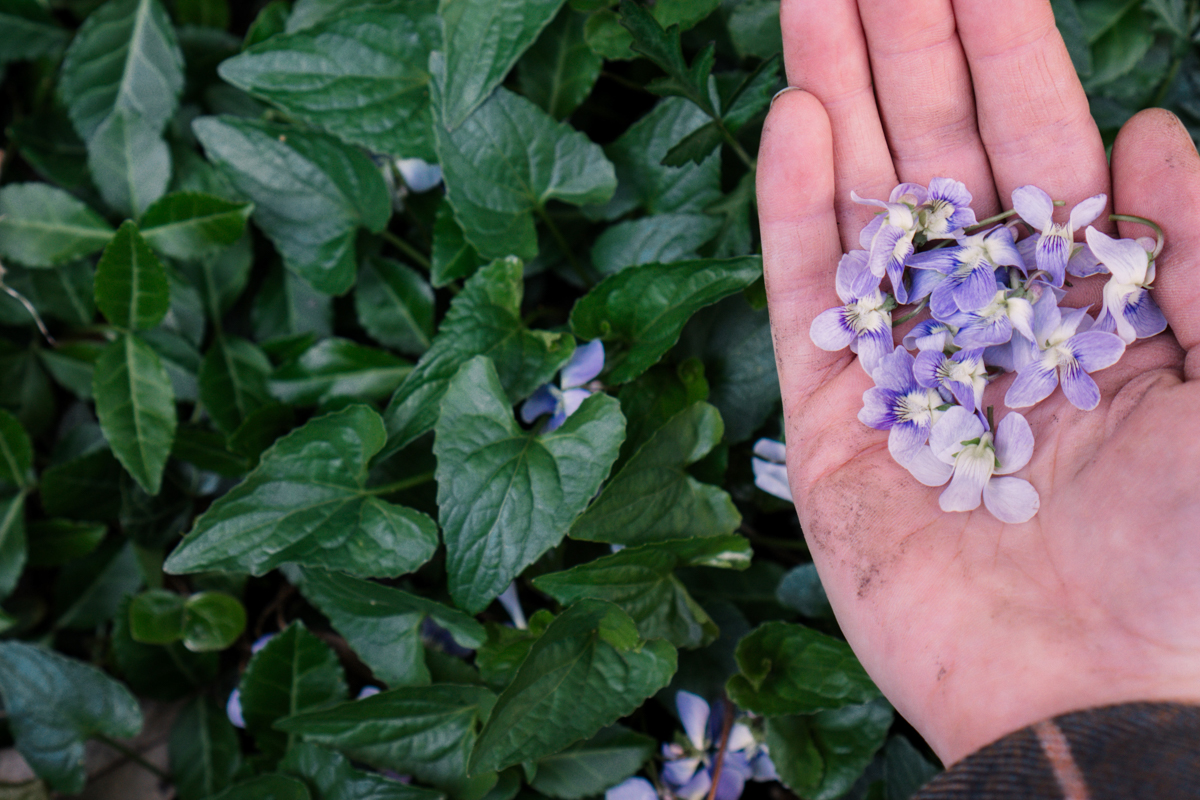
Edible Flowers
Whether you know just one species of edible flowers or a whole foray, the color imprinted on the tamales makes these a memorable edible wizardry. Stick to flowers you absolutely know are edible. You wouldn’t want to make this pretty meal even more memorable with a poisonous plant mishap! Herbs of use include but certainly aren’t limited to borage (Borago officinalis), calendula (Calendula officinalis), chive blossoms (Allium schoenoprasum), hibiscus (Hibiscus spp.) – in this case, you can use the petals, pansies, and violets (Viola spp.), and rose (Rosa spp.), or go off the flower beat and use leaves of basil (Ocimum basilicum), dandelion (Taraxicum officinale), mints (Mentha spp.), mugwort (Artemisia vulgaris), and other whimsical garden herbs. Your garden, neighborhood, wood, desert, mesa, or meadows may have completely different plants to adorn your tamales with, and that is perfect!
For more ideas check out 9 Edible Flowers and How to Use Them by Herbal Academy team member Angela Justis, or for even more artistic inspiration visit https://loriastern.com/ as well as the suggestions in the recipe below.
This recipe and photography comes from Loria Stern (loriastern).
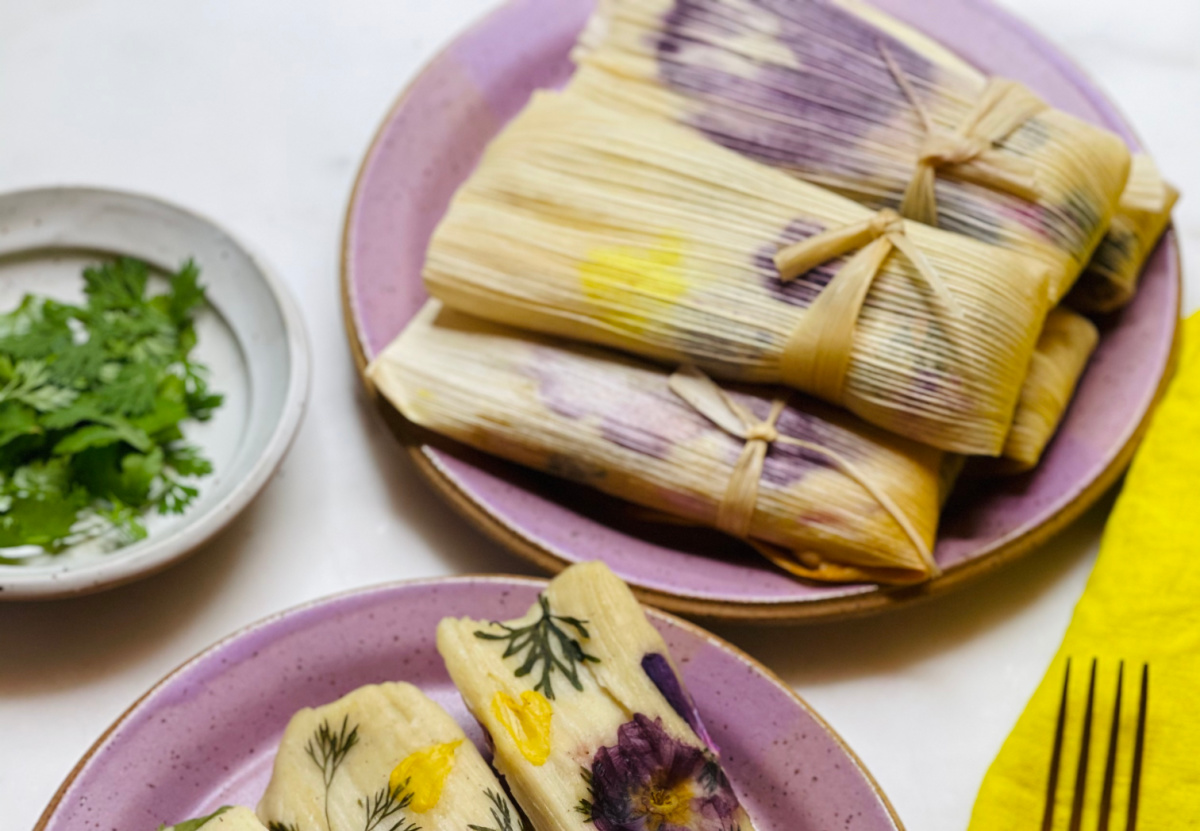
This is a fun twist on traditional tamales. Enjoy with rice and beans and a crisp salad. Yield: 9 tamales.
For the Hibiscus Jackfruit Filling:
2 tbsp. dried hibiscus flowers Tamales:
18 corn husksVegan Botanical Tamales With Hibiscus Jackfruit filling
1 tbsp. extra-virgin olive oil
1 medium yellow onion (8 oz.) thinly sliced
2 garlic cloves, finely minced
1 tsp. medium jalapeño (2 oz.), seeds and pith removed, finely chopped
20-oz. can young jackfruit in brine, drained, and broken up into shreds
1⁄2 tsp. kosher salt
1 tsp. chili powder
1 tsp. ground cumin
1 tsp. dried Mexican oregano
1 smoked paprika
Fresh lime juice
Cayenne pepper or ground chipotle chile (optional)
3 1⁄2 cups masa harina
1 tbsp. kosher salt
1 tsp. baking powder
3 cups vegetable stock
1⁄4 cup extra-virgin olive oil
1 cup assorted edible flowers, washed and patted dry (including brightly colored pansies, violas, sunflower petals, nasturtium blooms, and marigolds), mixed with soft, fresh herbs (such as cilantro, parsley, chervil, or tarragon)
Salsa or hot sauce, for serving (optional)
Spicy, pungent, fruity, floral, bitter, sour, and sweet. This meal has it all! The jackfruit is a little bit of a commitment, potentially to source, depending on where you live, and also to process, but the combination of this distinct fruit, a favorite to many who grew up with it or learned to cook it, and the harmony of all the other flavors are sure to thrill. We should mention that tamales can also be refrigerated for a short time or frozen for a long time, so it’s worth putting in the effort to create something so pleasing that is easy to eat whether on a summer night or when you need a hot delicious lunch on a chilly day. Combine with your favorite homemade hot sauce made from a blend of the summer’s last chilis and additional garlicky, fruity, and herbal flavors.
